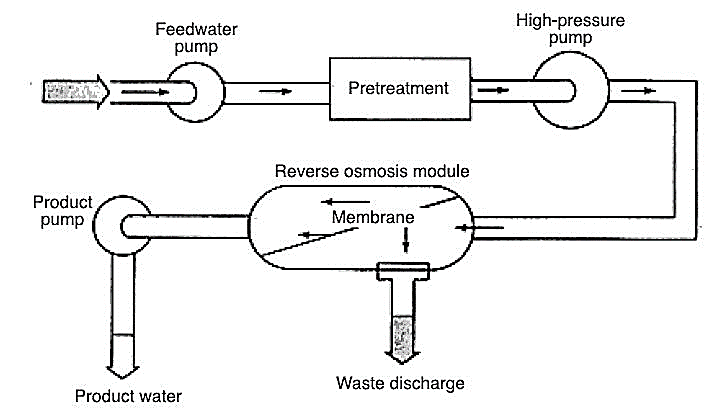
Seawater Desalination with Reverse Osmosis Plant
All Reverse Osmosis vegetation are basically Desalination Vegetation but desalination is remaining referred to sea water Commonly.As sea h2o has extremely significant TDS requires really significant pressure to force sea water by way of membranes which are distinct then brackish drinking water membranes.
Reverse Osmosis Plant Information:
A reverse osmosis plant is usually a producing plant, wherever h2o is purified and desalinated by forcing h2o via a membrane, ordinarily known as a reverse osmosis procedure. Water produced by plant RO might be used for a number of functions like desalination, wastewater therapy, as well as the reclamation of dissolved minerals.
RO Plant Description
An average drinking h2o RO plant procedure involves 6 KW hours of electricity to desalinate 1 cubic meter of h2o. Reverse osmosis drinking water plants requires a variety of pre-procedure procedures which include softening, DE chlorination, and anti-scale treatment method. Following pre-cure, higher levels of pressure mail h2o through a semi-permeable membrane, which retains all contaminants besides h2o.
RO Plant Layout
To enhance the performance and life of the Reverse Osmosis plant, productive pretreatment in the feed drinking water is required. Array of the best pretreatment will maximize effectiveness and membrane life by minimizing:
Fouling
Scaling
Membrane Degradation
RO plant style is consisting of:
Analyzing pretreatment requirement of Reverse Osmosis Plant
Should the feed h2o has traces of weighty metals, it is very suggested to dose some chlorine to change the dissolved major metals to physical kind, the media filter will filter most of it in the ro h2o purifier plant.
Reverse Osmosis Plant Selection of membrane
Membrane factors are a very important A part of RO vegetation. The proteins (primarily polyamide) that make-up membrane features vary dependant upon the ending clarity and ingestion h2o seawater or brackish h2o etc
Waterman engineers Australia RO plant for seawater desalination
Waterman Engineers in Australia has developed a Reverse Osmosis (RO) plant for seawater desalination, which delivers quite a few rewards about other desalination procedures. Below are a few vital great things about their RO plant:
Electrical power Performance:
In comparison to other desalination methods like thermal distillation, RO necessitates less energy. Waterman Engineers' RO plant makes use of Highly developed membrane know-how, letting it to function at reduced pressures and decrease General energy use.
Environmental Affect:
RO generates significantly less brine discharge in comparison with thermal techniques, reducing the effect on marine ecosystems. This aligns with Australia's give attention to environmental sustainability and conservation.
Higher H2o Purity:
The RO method successfully gets rid of salts, minerals, and impurities, generating superior-quality freshwater that fulfills stringent drinking drinking water standards. This dependability is crucial for delivering Secure and cleanse h2o to communities.
Modular Layout:
Waterman Engineers' RO plant employs a modular design, making it possible for for scalability and adaptability. This is particularly beneficial for parts with varying water needs, as modules is usually added or adjusted appropriately.
Lowered Footprint:
RO vegetation normally Have a very more compact physical footprint when compared to thermal desalination crops, which often need comprehensive infrastructure for heating and cooling procedures.
Quick Begin-Up and Shutdown:
RO vegetation might be begun and stopped relatively rapidly, enabling for greater responsiveness to transforming water needs and emergencies.
Lessen Chemical Usage:
Compared with some other desalination methods, RO needs less substances for Procedure and cleansing, minimizing chemical-associated environmental issues.
Regularity in Performance:
The RO course of action is considerably less sensitive to feedwater top quality fluctuations than other techniques, making certain a more steady efficiency with time.
Price-Success:
When Preliminary expense prices might be considerable, RO crops have a tendency to have decrease operational and maintenance expenditures Eventually in Desalination Plant Manufacturer comparison with thermal approaches.
Reverse Osmosis (RO) is really a drinking water purification course of action that uses a partially permeable membrane to eliminate ions, unwanted molecules, and larger particles from consuming water. By implementing tension to overcome osmotic strain, it enables the passage of drinking water molecules while rejecting contaminants, thereby developing thoroughly clean water on one side of your membrane and concentrated impurities on one other.
The Doing work principle of the Reverse Osmosis (RO) plant requires implementing pressure to the saline Remedy to pressure h2o molecules through a semi-permeable membrane. This membrane makes it possible for only drinking water to move when rejecting salts, contaminants, and impurities, causing purified h2o over the permeate facet along with a concentrated Remedy of contaminants about the brine facet.
Some great benefits of Reverse Osmosis include creating higher-top quality, clear water by getting rid of contaminants, becoming effective and cost-productive with time, requiring negligible chemical use, and staying adaptable to varied scales of operation from small dwelling units to substantial municipal vegetation.
RO plants have changed Demineralisation (DM) plants since they often give a extra successful and cost-efficient Alternative for drinking water purification. RO methods You should not call for the regeneration chemical substances that resin-centered DM vegetation do and will take away a broader range of contaminants, which include dissolved solids and microorganisms.
Waterman Engineers Australia probably uses Reverse Osmosis (RO) vegetation for seawater desalination by forcing seawater via a semi-permeable membrane to remove salt and various impurities. This process makes new, potable drinking water from the ocean, addressing water scarcity and giving a sustainable supply for a variety of requires.